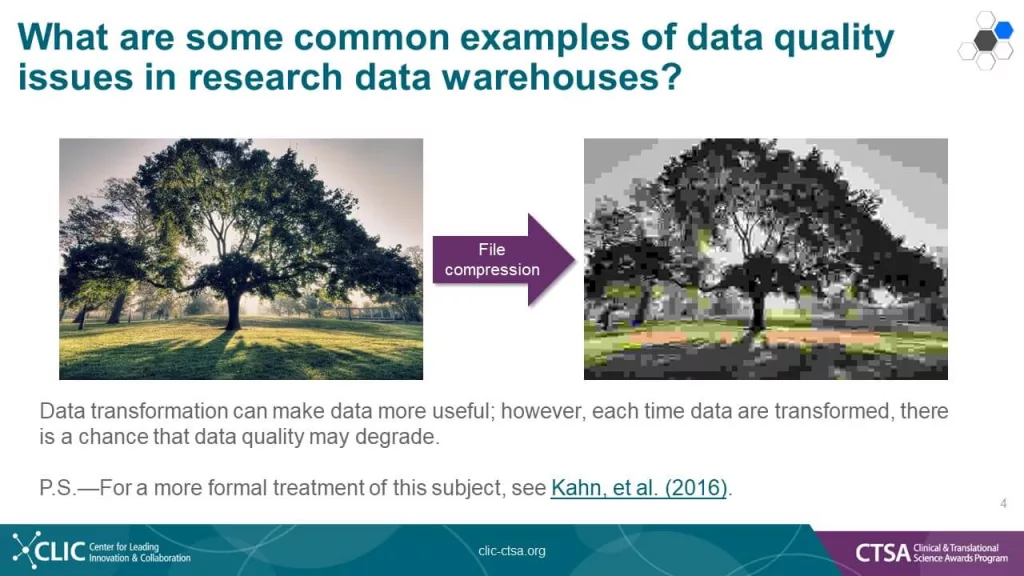- News
- Mike’s Blog
- CLIC News Roundup
- CTSA Ansible

Insights to Inspire 2021, Informatics: The Journey to Interoperability launched in July to help CTSA Program hubs improve their informatics capabilities. The first five webcasts in the series of 12 provide baseline knowledge to help you get started on your journey. Once you’ve mastered the basics, you’re ready to dive deeper into the next seven webcasts, which discuss how specifically to improve your data quality and processes, how to standardize your data and who you should include on your team.
Homing in on data quality, process improvement and data standardization
Emily Pfaff, Ph.D., the co-director of CTSA Informatics and Data Science Core at the University of North Carolina, Chapel Hill, discusses common data quality errors that occur in research data warehouses in the webcast Infrastructure and Data Quality.
“No matter how careful you are, it is almost inevitable that data quality issues will be discovered by end-users from time to time,” she said.
Institutions can avoid or remedy those errors by having processes in place, such as periodic auditing and maintenance time built into the scope of work for data warehouse builds. These processes can help save time in the long run.

In the webcast Process Improvement, Karthik Natarajan, Ph.D., an assistant professor of biomedical informatics at Columbia University, discusses the processes Columbia has implemented to improve its informatics common metric. Natarajan details how to identify critical partners for process improvement, how to validate data provenance and how Columbia checks data quality.
Data standardization is key to reaching interoperability, and Professor and Chair of the University at Buffalo Department of Biomedical Informatics Peter Elkin, M.D., explains why it is so important to the CTSA Program consortium in the webcast Data Standardization in Data Warehousing.
Creating your informatics team
Another key to boosting your institution’s informatics capabilities is the people with whom you work. You want to have a high-performing team with the training to execute your research vision, but how do you know who the right hires are?
“You should be looking for people who are creative and critical thinkers and that can adapt easily to changing environments,” said Michele Morris, a senior software architect at the University of Pittsburgh. Morris lists all key personnel needed for an informatics project in the webcast Personnel and Interdisciplinary Teams. She also breaks down the training they will need into three key categories: core research training, productivity and continuing education.
In the webcast Data Science Education for Informatics, Elkin joins Professor and Director of Galter Health Sciences Library at Northwestern University Kristi Holmes, Ph.D., to talk more in depth about training and educational resources, some of which are available to anyone in the CTSA Program.
“I really think we’re all much stronger when we work together as a community than when we work alone, and collaboration beats competition every time,” Elkin said.
Once you have your core team, you can think about external data partners and networks with which you can collaborate. Partnering with others allows you to benchmark your data against those institutions, which can help you identify, investigate and correct possible errors. In the webcast Partners and Networks, Jeanne Holden-Wiltse, MPH, MBA, senior associate and CTSI Informatics director in the University of Rochester (UR) Department of Clinical and Translational Research, discusses the most impactful partnerships for the UR hub and why partnerships are important.
“Local hub resources are limited,” she said. “So let’s use the power of the network. Sharing code, data models and best practices improves our network data and our local hub data.”
Reaching interoperability
In the final webcast, How to Get to Interoperability, Adam Wilcox, Ph.D., a professor of biomedical informatics and medical education at the University of Washington (UW), and chief analytics officer at UW Medicine, uses examples to demonstrate what interoperability is.
“Interoperability allows hubs to share data across sites in a more useful way,” he said. “How they use it is important. It’s not just sending the information; it’s making sense of the way data can be used.”
View the full Insights to Inspire resource kit to join the journey to data interoperability.
